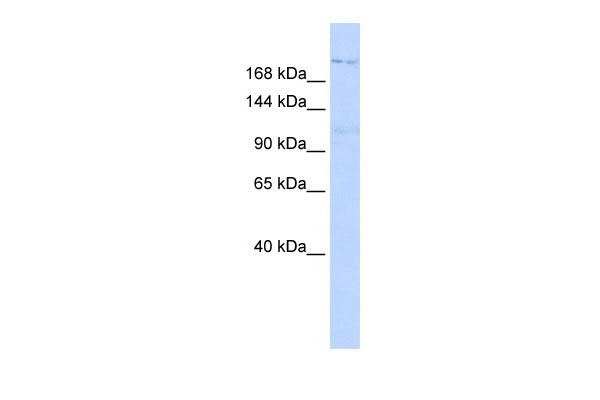INADL antibody - N-terminal region
Rabbit Polyclonal Antibody
- SPECIFICATION
- CITATIONS
- PROTOCOLS
- BACKGROUND

Application
| WB |
|---|---|
| Primary Accession | Q8NI35 |
| Other Accession | NM_176877, NP_795352 |
| Reactivity | Human, Mouse, Rat, Rabbit, Horse, Bovine, Guinea Pig, Dog |
| Predicted | Human, Mouse, Rat, Rabbit, Horse, Bovine, Guinea Pig |
| Host | Rabbit |
| Clonality | Polyclonal |
| Calculated MW | 196kDa |
| Gene ID | 10207 |
|---|---|
| Alias Symbol | Cipp, FLJ26982, PATJ, hINADL, InaD-like |
| Other Names | InaD-like protein, Inadl protein, hINADL, Pals1-associated tight junction protein, Protein associated to tight junctions, INADL, PATJ |
| Format | Liquid. Purified antibody supplied in 1x PBS buffer with 0.09% (w/v) sodium azide and 2% sucrose. |
| Reconstitution & Storage | Add 50 ul of distilled water. Final anti-INADL antibody concentration is 1 mg/ml in PBS buffer with 2% sucrose. For longer periods of storage, store at 20°C. Avoid repeat freeze-thaw cycles. |
| Precautions | INADL antibody - N-terminal region is for research use only and not for use in diagnostic or therapeutic procedures. |
| Name | PATJ {ECO:0000303|PubMed:22006950, ECO:0000312|HGNC:HGNC:28881} |
|---|---|
| Function | Scaffolding protein that facilitates the localization of proteins to the cell membrane (PubMed:11927608, PubMed:16678097, PubMed:22006950). Required for the correct formation of tight junctions and epithelial apico-basal polarity (PubMed:11927608, PubMed:16678097). Acts (via its L27 domain) as an apical connector and elongation factor for multistranded TJP1/ZO1 condensates that form a tight junction belt, thereby required for the formation of the tight junction-mediated cell barrier (By similarity). Positively regulates epithelial cell microtubule elongation and cell migration, possibly via facilitating localization of PRKCI/aPKC and PAR3D/PAR3 at the leading edge of migrating cells (By similarity). Plays a role in the correct reorientation of the microtubule-organizing center during epithelial migration (By similarity). May regulate the surface expression and/or function of ASIC3 in sensory neurons (By similarity). May recruit ARHGEF18 to apical cell-cell boundaries (PubMed:22006950). |
| Cellular Location | Cell junction, tight junction. Apical cell membrane; Peripheral membrane protein. Cytoplasm, perinuclear region. Note=Localizes to the apical region at the start of epithelial cell polarization then locates to tight junctions as polarization is completed (PubMed:11964389). Localizes to the most apical strand of TJP1/ZO1 condensates during junctional condensation elongation (By similarity). Localized in the paranodal region of myelinating Schwann cells (By similarity). Localized to the leading edge of the actin cortex of migrating epithelia cells (By similarity). {ECO:0000250|UniProtKB:E2QYC9, ECO:0000250|UniProtKB:Q63ZW7} |
| Tissue Location | Expressed in renal tubules (at protein level) (PubMed:19755384). Expressed in bladder, testis, ovary, small intestine, colon, heart, skeletal muscle, pancreas and cerebellum in the brain. |

Thousands of laboratories across the world have published research that depended on the performance of antibodies from Abcepta to advance their research. Check out links to articles that cite our products in major peer-reviewed journals, organized by research category.
info@abcepta.com, and receive a free "I Love Antibodies" mug.
Provided below are standard protocols that you may find useful for product applications.
If you have used an Abcepta product and would like to share how it has performed, please click on the "Submit Review" button and provide the requested information. Our staff will examine and post your review and contact you if needed.
If you have any additional inquiries please email technical services at tech@abcepta.com.













 Foundational characteristics of cancer include proliferation, angiogenesis, migration, evasion of apoptosis, and cellular immortality. Find key markers for these cellular processes and antibodies to detect them.
Foundational characteristics of cancer include proliferation, angiogenesis, migration, evasion of apoptosis, and cellular immortality. Find key markers for these cellular processes and antibodies to detect them. The SUMOplot™ Analysis Program predicts and scores sumoylation sites in your protein. SUMOylation is a post-translational modification involved in various cellular processes, such as nuclear-cytosolic transport, transcriptional regulation, apoptosis, protein stability, response to stress, and progression through the cell cycle.
The SUMOplot™ Analysis Program predicts and scores sumoylation sites in your protein. SUMOylation is a post-translational modification involved in various cellular processes, such as nuclear-cytosolic transport, transcriptional regulation, apoptosis, protein stability, response to stress, and progression through the cell cycle. The Autophagy Receptor Motif Plotter predicts and scores autophagy receptor binding sites in your protein. Identifying proteins connected to this pathway is critical to understanding the role of autophagy in physiological as well as pathological processes such as development, differentiation, neurodegenerative diseases, stress, infection, and cancer.
The Autophagy Receptor Motif Plotter predicts and scores autophagy receptor binding sites in your protein. Identifying proteins connected to this pathway is critical to understanding the role of autophagy in physiological as well as pathological processes such as development, differentiation, neurodegenerative diseases, stress, infection, and cancer.


